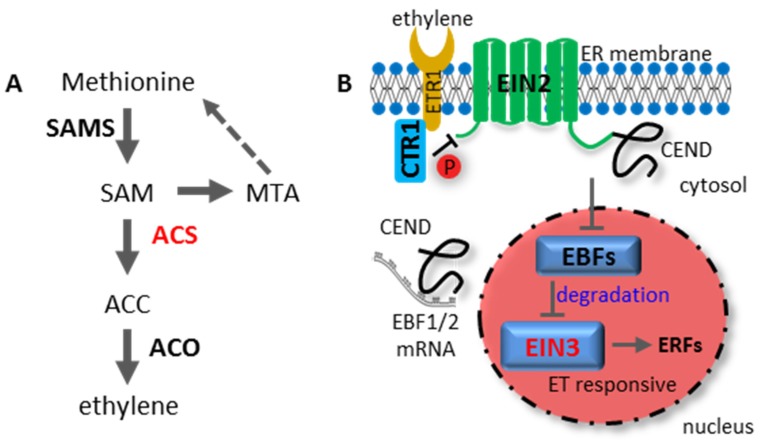Figure 2.
Ethylene (ET) biosynthesis and the signaling cascade pathway. (A) Model for the ET biosynthesis pathway. The precursor SAM is produced by SAMS with methionine as substrate. SAM is converted to the intermediate chemical ACC by ACS with the release of MTA as byproduct. MTA is recycled to methionine through the so-called Yang cycle. The rate-limiting enzyme ACS is highlighted in red. (B) Model for the ET signaling cascade. In the absence of ET, CTR1 phosphorylates EIN2 and the ET pathway is therefore blocked. In the presence of ET and when it is perceived by ET receptor (i.e., ETR1, ETHYLENE RESISTANT 1), the kinase activity of CTR1 is inactivated, the EIN2 CEND becomes dephosphorylated and cleaved. CEND subsequently translocates into the nucleus to attenuate EBFs E3 ligase function. In addition, CEND may bind to the UTR of EBF1/2 mRNA to perturb EBF1/2 translation in cytosol. Stabilized EIN3 protein then activates ERF transcription factors (i.e., ERF1 and ORA59) to elicit the ET response. Abbreviations: ACC, 1-Aminocyclopropane-1-carboxylic acid; ACO, ACC-oxidase; ACS, ACC synthase; CEND, C-terminal end of EIN2; CTR1, constitutive triple response 1; EBF1/2, EIN3-binding F-Box 1/2; EIN, ethylene insensitive; ER, endoplasmic reticulum; ERF, ethylene-response factor; ET, ethylene; ETR1: ethylene-resistant 1; MTA, methylthioadenosine; SAM, S-adenosyl methionine; SAMS, SAM synthase.

